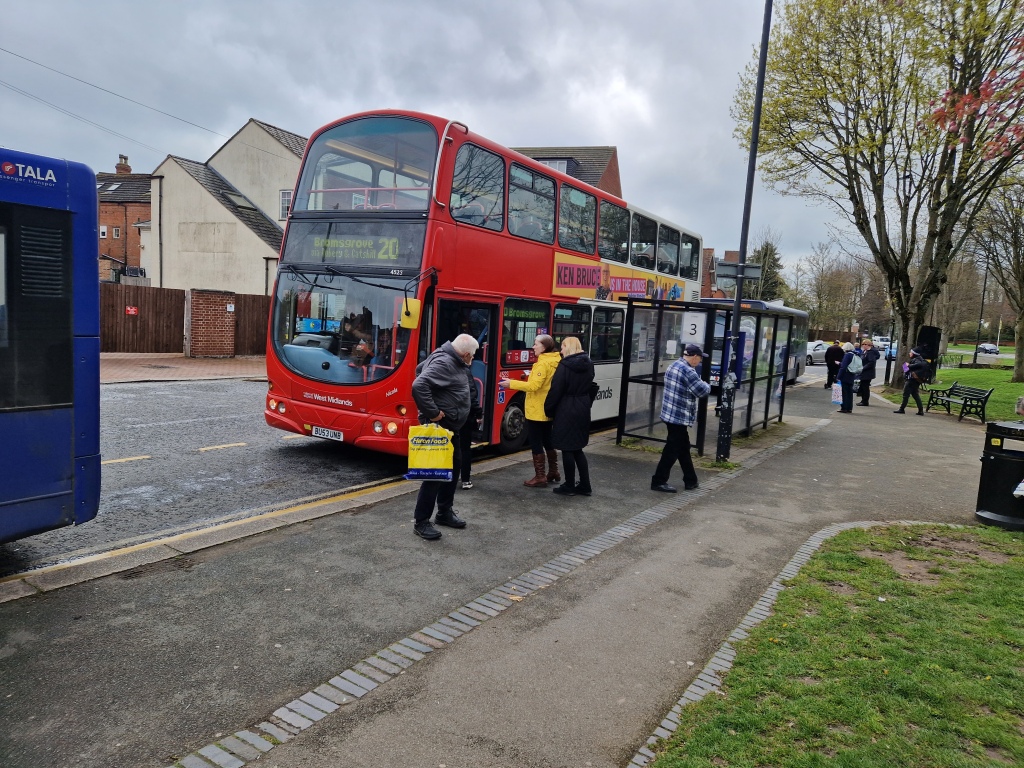
I was planning another “Just £2” bash today but the late rescheduling of a church worship group practice lead to me needing to do something more local, which, in the event, would be rather fortuitous, allowing me to sample an extended route that had started the previous day!
You may recall last year that great controversy was caused when First withdrew the Birmingham-Catshill section of the long established 144 from Worcester (see blog “Birmingham No More On The 144”) and it’s last minute replacement by National Express West Midlands (NXWM) route 144A from Longbridge Station-Bromsgrove, subsidised by Worcestershire County Council, upon which I would do a trip last June (see blog “NXWM 144A & Other Stuff”). Yardley Wood garage ran the route, mostly with Scania Omnilink saloons, such as 1928, which I travelled on, and seen here at Bromsgrove bus station;

1928-Bromsgrove bus station
……though the odd double decker would appear, from a Dennis Trident to one of the electric MMC E400 BYDs bought in 2020 for the 6 (Birmingham-Solihull via Shirley.)
At the time of it’s commencement, NXWM promised to look at ways to integrate the route better with the NXWM network, with the main aim being to introduce an hourly frequency to replace the awkward to remember seventy minute headway neceserry for the 144A to be operated by just one bus. This would be achieved from this Sunday just gone, the 16th April, with the route being replaced by the rerouting and extension of the 20. This route started on 29th August 2021, replacing the former X20 that had been one of three Platinum branded City-University services introduced in July 2018 (See “Buses For Fun” blog “South Birmingham Changes-Part Two”) which would prove to be slightly over bussed, especially after the reduction of loadings following the pandemic, so what was considered to be the weakest of these, the X20 to Cofton Hackett, was replaced by the 20, which started from the Queen Elizabeth (QE) Hospital, and was operated by Yardley Wood garage, mostly using Scania Omnilink saloons, as most journeys interworked at Cofton Hackett with the traditionally single deck (due to the low bridge at Bourneville Station) 27.
However, the revisions that took place on January 1st this year, saw the 20 somewhat surprisingly transferred to West Bromwich garage, balancing out resources made spare from reductions in the West Bromwich area (notably the withdrawal of West Bromwich services 45 & 46, plus the Northfield section of the 48 from West Bromwich, the latest of several extensions over the past few years, of the 48 beyond QE Hospital) and helping to relieve driver shortages at Yardley Wood, which was barely affected by the service reductions. Interworking at the QE with the 48, the transfer saw double deckers become regular on the service, with a particular predominance of West Bromwich’s survivng Wright Gemini bodied Volvo B7s, now the oldest buses in service at that garage, and some of the oldest buses in the whole NXWM fleet.

4508-Cofton Hackett
Now though, one journey per hour on the 20 has been rerouted to head off Lickey Road and make it’s way to Rubery, from where it replaces the 144A to Bromsgrove. Meanwhile, the other journey, including the hourly evening journeys, continues to run to Cofton Hackett as the 20A.
So, this seemed the obvious move for today, but particularly, I decided that, having ridden a Gemini (4508) on the 20 to Cofton Hackett (see blog “New Year Freewheeling”) it would be nice to get one on the Bromsgrove extension before they start to disappear, this likely to be the case relatively soon, with those not up to Euro Six emissions standard destined to be withdrawn next month, as part of an agreement with Transport for West Midlands (TfWM) to be rid of such buses by May, whilst the recently announced order for 170 more ADL MMC E400 BYDs, following on from the 130 that are currently entering service at Coventry, and part of an announced desire to purchase 300 electric buses during 2023 & 2024 (the other 130 being highly likely to be Wright Streetdeck Electroliners) means that all of the company’s remaining Wright Gemini bodied Volvo B7s, plus it’s 80 remaining Dennis Tridents, will be replaced within the next two years.
Fortunately, a boon for finding out exactly which buses are running on which route is the bustimes.org website, although with this level of interworking, I also had to look at what was on the 48A, which interworks with the 48 at West Bromwich. Fortunately, although two E400s and a Scania Omnilink saloon were also out on the 20/20A/48/48A, the vast majority of buses on the route today, including a couple at the time I looked on the 48A, were Wright Gemini/B7s, so I immediately left the house and walked to my local bus stop, where, as soon as I looked upon the electronic bus due display, the Gemini fest began when 2003 vintage 4514 turned around the corner on the 47 from Wednesbury, so I boarded for the short trip to West Bromwich bus station, where the driver changed his blinds to 47E Hydes Road, making me suspect that the bus was running late;
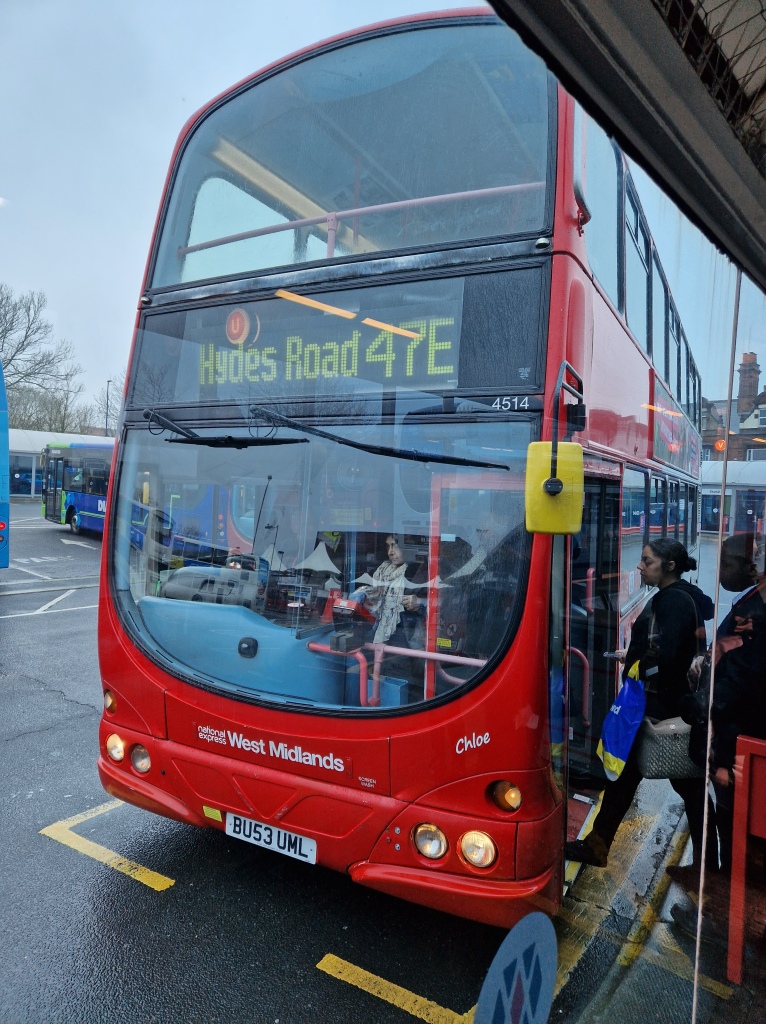
The 48
And so I waited for the next 48 to leave, which was 4516, like 4514, from the company’s first batch of Gemini B7s from 2003, with both also being allocated to my garage at Perry Barr, with 4516 being the final example numerically to be allocated to Perry Barr that year.

To be honest, I wasn’t sure whether 4516 would do a 20 or 20A from the QE, but it didn’t matter, as bustimes said that the bus behind it on an incoming 48A was 4521, so it was no problem waiting at the QE for half an hour for another Gemini if need be, so I boarded, and we then headed down Spon Lane and across into West Smethwick, soon heading out into the Warley area of suburbia and up to the attractive stretch of route past Warley Woods, then down into Bearwood, this being the route of the 1947 introduced 221 joint service between West Bromwich Corporation and Midland Red, these passing to the West Midlands Passenger Transport Executive (WMPTE) in October 1969 and December 1973 respectively. August 1980 saw the 221 replaced by the new 448, running across West Bromwich to Charlemont Farm (replacing the 438) although November 1983 would see the route split again, with Charlemont Farm becoming the 408. Deregulation in October 1986 saw the 448 extended the other way, onto the QE via Harborne, so we then headed out of Bearwood, leaving Sandwell across the Hagley Road and following the 11A/11C Outer Circle route down affluent Lordswood Road to Harborne, where we joined Harborne High Street for the run through this busy shopping area to the Green Man pub at the other end, where we turned into another affluent area of large houses leading us into the area where Birmingham University and the QE hospital complexes surround us. We then headed up to the congested QE entrance, where buses jostle with other traffic to reach their stops on the other side. Once there, we unloaded, with me expecting the bus to be the 09.32 20A, though we were slightly late for this, but no, the driver put “Not In Service” on the blinds and then pulled off, which left me speculating whether the bus was returning to garage at the end of the peak, or going to park up somewhere.
For those wishing to seek out NXWM’s oldest buses, the QE is quite a good place to start, for as well as West Bromwich’s Geminis appearing on the 20, 20A and 48, Yardley Wood’s Dennis Tridents are also common visitors on the lenghty 76 from Northfield-Solihull, with 4586 passing through whilst I waited for the 20.
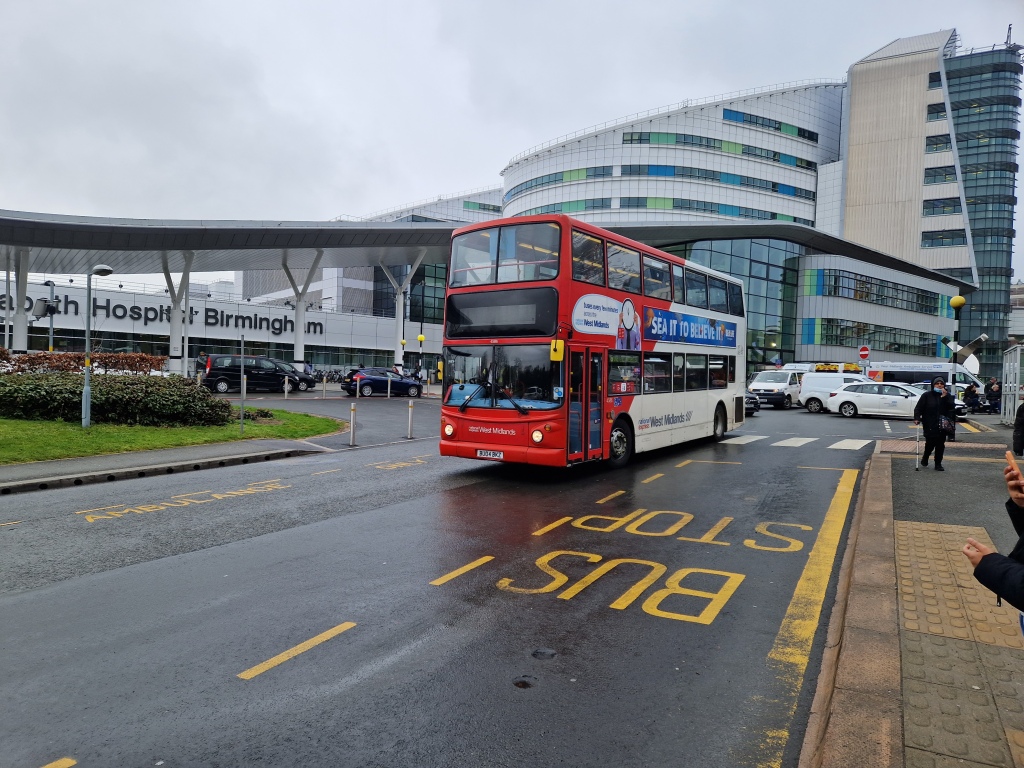
Then, just before the 20 was due, 4516 returned from where ever it had been and pulled up to the relevant stop with 20 Bromsgrove on the blinds;
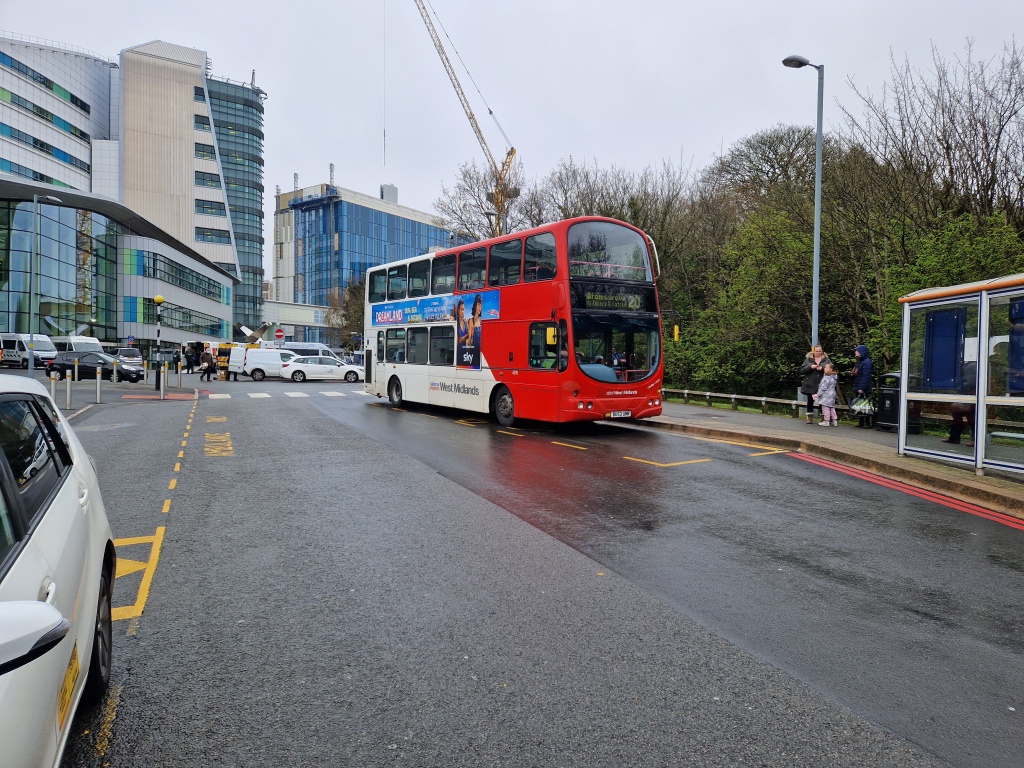
The 20
So, after only around four months since my trip on 4508 on the route of the original 20 to Cofton Hackett, I was once again heading along the same course, on a member of the same batch of buses! I was one of the few of the half dozen or so passengers who boarded to go upstairs, easily grabbing the front seat and we then ventured forth to Selly Oak, passing the abandoned, early eighties Sainsburys that has been replaced by a newer, larger store in a nearby retail park, with a recent announcement by West Midlands Mayor Andy Street saying that the abandoned store is now set to be demolished to make way for new housing. We then joined the Bristol Road, alongside the Birmingham Central allocated E400s & MMC E400 Platinums on the 61 & 63 routes and passing alongside the tree lined central reservation that once housed the reserved track used by the Bristol Road trams, this leafy road taking us into Northfield, a major suburban shopping centre where several suburban bus routes meet up. Passing through, the 61 leaves us, that route being introduced on 6th July 1952, the day the Bristol Road trams ceased, providing a direct service from City to the thirties built Allens Cross estate and now reaching out to Frankley. We though, continued alongside the 63, the route that replaced the 71 tram to Rubery, though again, this now reaches the seventies built estate of Frankley (See blog “A Saunter Around South Birmingham.”)
The Bristol Road continued alongside more former tramway reservation, heading through more semi detached clad suburbia, though not as leafy as the Selly Oak-Northfield section, this taking us to the much rebuilt Longbridge, once home to the vast Austin, later Rover car factories, but now a gradually rebuilt shopping and leisure centre, the centrepiece being the new base of the former Bourneville College. Here, we met the former 144A route, which popped out of Longbridge Lane, from where it had started by Longbridge Station, but then followed the 63 onto the remainder of the Bristol Road, which turns right here, with the road straight on becoming Lickey Road, containing more former tramway reservation, this being the route of the most famous of the Bristol Road tram routes, the 70 to Rednal, famous for bringing hoardes of city weary Brummies out to the Lickey Hills, gifted to the city by the Cadbury family in 1905 and summer bank holidays seeing tram after tram heading full to the large turning circle built to handle such crowds at Rednal terminus. Replaced by the 62 bus, the glory years began to pass, with the day to day traffic to Rednal being no where near as remunerative, making this the quietest of the Bristol Road routes at normal times, so more recent years have not been kind to the route, an abortive, July 2010 introduced X62 which was planned to entice Lickey Road residents out of their cars but failed to do so, being replaced by the 98 via QE Hospital a year later, which would in turn, be replaced by the X20 through to Cofton Hackett in July 2018.
As we travelled along Lickey Road, a company representative got on, who clearly recognised me, and was handing out that rare commodity, a timetable leaflet that had been especially produced to explain the changes! His name was Matt, and it was useful that such staff were on hand to provide advice, particularly as TfWM hadn’t changed the timetables in bus stop cases, nor refreshed the route numbers on the flags! And Matt said that Worcestershire had got their timetables onto stops, though this was mostly just a perspex sheet!
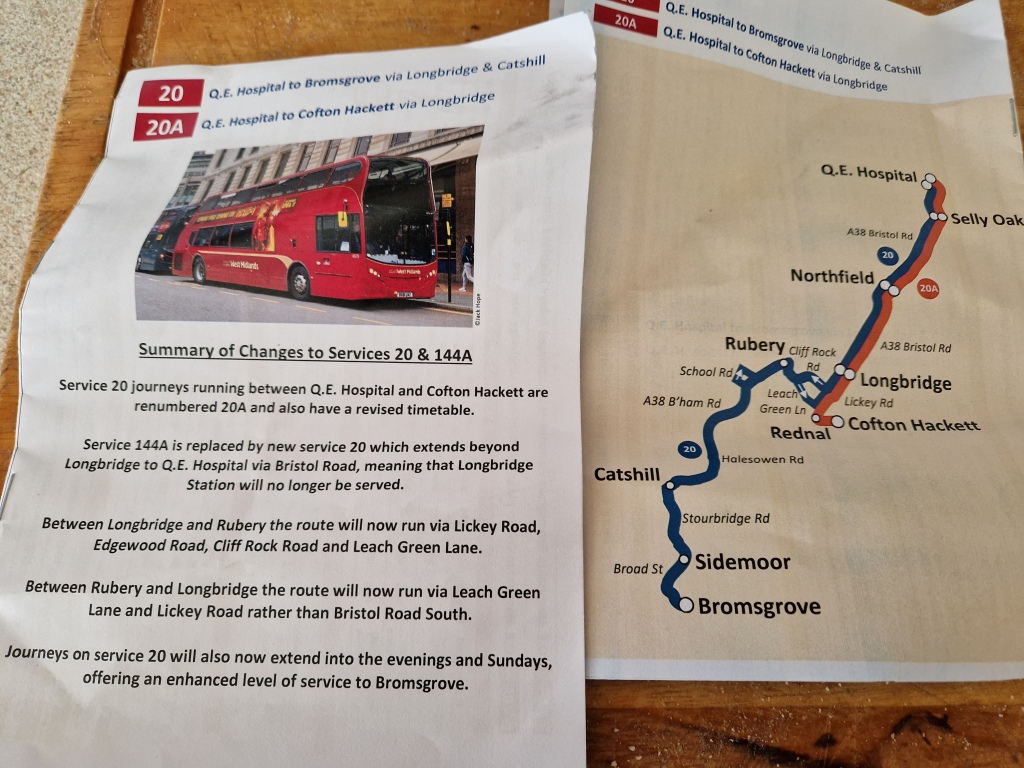
Whilst the 20A now provides just an hourly service down past the former Rednal tram terminus and down to the Worcestershire village of Cofton Hackett, the 20 now turns right onto Edgewood Road. When the X20 first started, it originally ran out of Longbridge via Bristol Road, then turned left onto Edgewood Road, bringing it down to Lickey Road, from where the route momentarily headed back towards Longbridge but then turned right onto Lowhills Lane, where new housing was then being built on land that was once more car factories, and then heading through Cofton Hackett to terminate at Rednal Traffic Island, but due to complaints from Lickey Road residents, the service was rerouted back via the traditional 62 route, then carrying onto Cofton Hackett. But Edgewood Road had been served once before, around 1993, by a short lived rerouting of the 49 (then Solihull-Northfield) which had most certainly not been made welcome by some residents along there, with drivers being threatened and buses damaged, leading to the 49 soon returning to it’s original Bristol Road routing between Longbridge & Rubery. No such occurances have happened in more recent times, so presumably, the trouble makers have moved on! Kevs Travel’s rambling tendered 55 route, from Rubery Great Park-Quinton, also passes along part of here.
We then turned left into Cliff Rock Road, which took us to Leach Green Lane, the road that links Rednal with the city boundary by Rubery, and served in the main by Diamond’s 202 (Bromsgrove-Halesowen) as mentioned in the “NXWM 144A” blog. The 20 now also does the full length of the road in the other direction, so I’ll talk a little more about it on the return trip. Soon, we were at the Bristol Road again, right by the city boundary, and the beginning of the Rubery Flyover that takes through traffic away from Rubery Vilage, which is just inside Worcestershire. The beginning of the flyover is actually in the path of the former 71 tram terminus, this being replaced by the 63 bus, which continued to terminate at this point (though obviously, on the road, rather in the former tramway reservation) until 7th February 1972, when it was extended through Rubery Village, then up Callowbrook Road to a new terminus on Rubery Lane, on the edge of what was to become the Frankley development.
And it was into Rubery Village that we would go, passing 4510 on the 20 heading the other way;
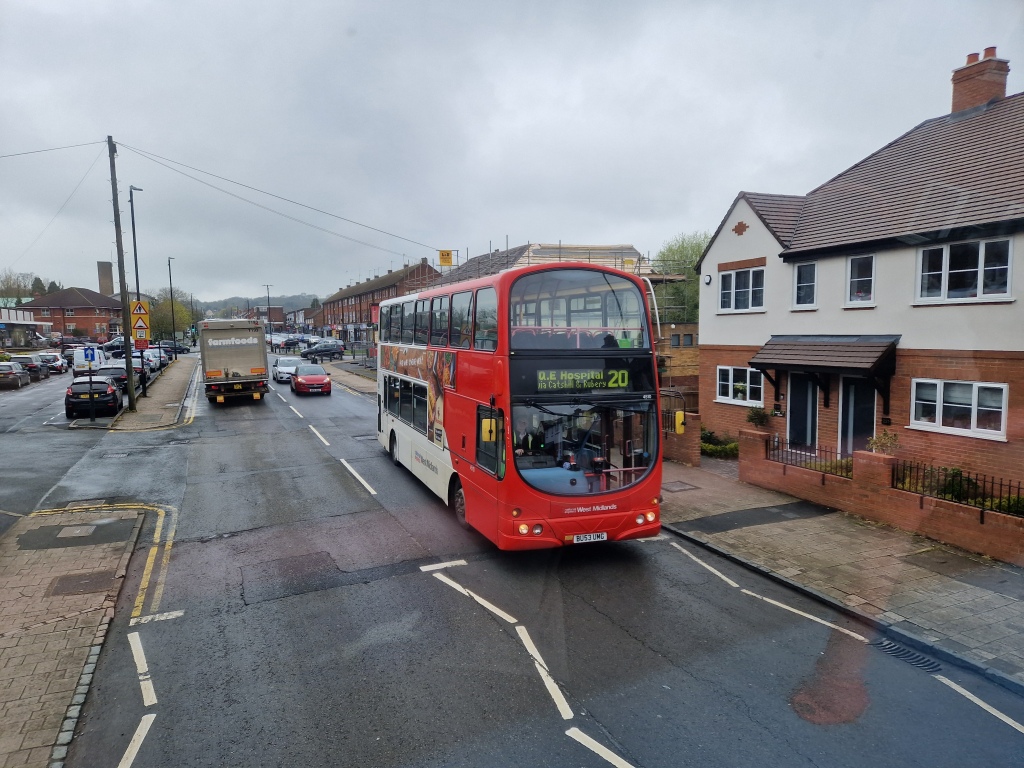
…….and heading through the small shopping centre, carrying on past where the 63 and Yardley Wood operated single deck service 27 head up Callowbrook Road, and headed out towards the end of the by pass, with the First Salt Road flags promoting the erstwhile 144 still surviving on the bus stops! And so we joined the dual carriageway that comes off the flyover, then headed down the open road, the countryside looking so much better from the top of a double decker, making me think of the days up until 30th Sepetember 1976, when BMMO D9s reigned on a 144 heading through to Malvern Wells. Ohhh, go on then, let’s have a photo of a D9! Though not one that was ever used on the 144!

5399-Wythall Transport Museum
The dual carriageway took us to Junction 4 of the M5, after which we continued down the A38, heading into the outskirts of Bromsgrove, turning off the main road at the Marlbrook to head around the Catshill & Sidemoor areas, where we picked up a couple of passengers, which must nark First a bit, as the 144 still terminates in this area, providing a twenty minute service into Bromsgrove and onto Worcester. Anyhow, we continued around this suburban sprawl, and eventually ended up at Bromsgrove bus station;

Bromsgrove
My original plan was to catch Diamond’s 145 via Barnt Green back to Longbridge, but, having enjoyed my run on 4516 so much, and with bustimes telling me that the next 20 would be 4523, another 2003 Wright Gemini bodied Volvo B7, I decided to hang around for it, allowing me to visit the Market Place Fish Bar, right on the corner of the short road that leads from the bus station onto the pedestrianised High Street. I’ve only noticed this shop on my past couple of visits, so I’m guessing that it hadn’t been there very long. In fact, way back at the time of my eighties & nineties visits to the town, I’d used a chippy right at the other end of that High Street, which I don’t think is there anymore. There’s a small cafe inside the Market Place Fish Bar but, as the weather was dry and, certainly compared to my recent trips, not too cold, I decided to have a takeaway, and sit and eat them on a bench to watch the various Diamond buses that are the main staple of bus services into Bromsgrove, plus First’s frequent Salt Road branded Volvo B7s that feature mostly on the 144, one of which is visible behind 4516 in the photo above, alongside a Diamond Optare Solo.
Before heading to the chippy, a guy called Jack, whose camera was a tell tale sign that he was a fellow enthusiast, introduced himself to me. Hi Jack! And so I went to the chippy, where a fish was especially put in for me, so I chatted away with the friendly staff until it was cooked, with me then selecting a bench in the attractive grassed area that lies between the bus station and the main road to eat them. Yeah, they were really nice, another chippy on my list! And thus I spent a pleasant hour watching the buses go to and thro, including a 144 driven by my friend Anthony, an ex Perry Barr driver whose now at First Worcester, so I had a brief chat with him as he waited time. You would have last met Anthony in my blog “Adventures In Dorset 2022-Part Three” when I met up with him at Weymouth’s Red Lion pub (2024 update; Anthony’s just transferred to First’s Weymouth garage, an area he dearly loves!) Then, at the appointed time, 4523 appeared;

My friend Andy Lunn, who’s a scheduler at West Bromwich but I’ve known since November 1984 when we met on the 4108 Route Tour, an enthusiast trip on what was then West Bromwich garage’s oldest surviving Daimler Fleetline, was on board. Andy was doing what Matt had been doing on the previous trip, so we had a brief chat, noting how we both thought that loadings seemed to be reasonable, before I went upstairs and grabbed the front seat again. Sitting opposite me were two ladies who were discussing the new service and it’s predecessers.
“It’s disgusting how First cutback the 144! And they’re so expensive too! These are much cheaper! And it’s much better now they’re running through to Northfield again!”
Then, we were off, back out around Catshill and up the A38 to the outskirts of Rubery, where we used the road that goes over the Rubery By Pass to get to the right side of the road into Rubery Village. Then it was onto Leach Green Lane, which, as I mentioned earlier, we followed fully in this direction. I’d not been on a double decker along the whole length of the road since 1984! For up until April 1984, Leach Green Lane was served by the 64, orignally a 1979 introduced Northfield-Frankley service but extended in the August 1980 West Birmingham revisions via Rubery & Leach Green Lane to Longbridge, with peak journeys supplementing the 49 route by continuing to Cotteridge. Always a quiet run, April 1984 saw the 64 replaced by a rerouted and extended 49 to Northfield (this section is now covered by the 27) which ran from Longbridge-Rubery direct via Bristol Road, though a peak WMPTE service was retained along Leach Green Lane with the 48 (No connection with the West Bromwich 48! The only time I would ride this 48, just after it started, was on a Selly Oak garage Leyland National) from Frankley-Cotteridge, with deregulation seeing it gradually reduced to extinction.
What was by then NXWM would return to Leach Green Lane in July 2010 with the aforementioned, ultimately unsuccesful X62, it’s daytime journeys using the lane to go beyond the 62’s former Rednal terminus to reach the attractions of the Rubery Great Park Leisure complex, this route also being used by the replacing 98 until it’s July 2018 replacement by the X20, but both X62 & 98 would use single deckers, double deckers not returning to the whole of Leach Green Lane (the X20 would initially use the Rubery end in the to city direction) until this weekend with the rerouted 20! So it was nice to relive the days of the 64 with this double deck ride.
We soon reached Leach Green Lane’s end and turned left into Lickey Road, within a stone’s through of the old Rednal tram terminus, which ceased to be used as a bus terminus at deregulation, the 62 then terminating by the Leach Green Lane junction. And so we turned left, served that stop that was the 62 start point from 1986-2010, and made our way down Lickey Road to Longbridge, where I decided to get off, as I wanted to sample a newer Wright Gemini bodied Volvo!
The 47
My aim now was to travel on one of the 2011 or 2013 delivered Wright Gemini 2 bodied Volvo B5 hybrids, the then big thing in trying to reduce the bus’s carbon footprint, with a battery powered by a small diesel engine, enabling the battery to be used in areas with heavy emissions. Adopted with gusto by London (most notably the “Borismaster” New Routemaster) the breed enjoyed more limited coverage elsewhere, including two batches of two types built for NXWM. The 2011 batch consisted of nine of those Wright Gemini 2 bodied Volvo B5s (5501-5509) plus nine of it’s main rival, the ADL E400H (5401-5409) both batches being allocated to Birmingham Central garage for use on the then 22 & 23 services through Harborne.
The second batch came in 2013, consisting of a further nine B5s (5510-5518) plus twelve more E400Hs (5411-5421) and were allocated to Wolverhampton for the 1 (Tettenhall Wood-Dudley.) 2014 would see the decision made to concentrate each type at one specific garage, with the E400Hs all being concentrated at Wolverhampton, whilst the B5s would be allocated to Birmingham Central, where they would continue on the 22 & 23 until Platinum standard MMC E400s (such was the rate of progress that the fully diesel Euro 6 engines of these produced less emissions than the hybrids, in fact, the Wolverhampton E400Hs-joined in 2020 by more examples from National Express’s then Explore Dundee operation-have now been retrofited with standard euro six diesel engines, though this dosen’t look to have been possible with the B5s) took over the Harborne corridor, with the B5s moving onto the 61 & 63 Bristol Road routes. It was on those routes that I would last ride on a couple, last year, having 5511 on a 63 from Northfield-Frankley, then 5508 on a 61 all the way into City, as recorded in the blog “A Saunter Around South Birmingham.”
But since then, late last year, mainly down to a relatively low capacity on the lower deck, which was proving to be a hindrance to an incresingly returning to pre pandemic level of loadings along the Bristol Road, it was decided to transfer the B5s onto the quieter Pershore Road routes. They’re buses that I don’t get to travel on that often, giving them a bit of rarity appeal to me, so I decided that I’d like to catch one now, preferably on the 47, as I haven’t been on that route since 2018, when there was a proposal to extend the 45 to replace the 47 (see “Buses For Fun” blog “On The Way Out-Part Three”), though I felt at the time that this would be totally impracitical and so it would ultimately prove, the July 2018 revisions seeing the route survive but get rerouted to Longbridge, terminating at the same place as the 45 now does. The last time I rode the 45, however, was last year, ironically on the way out to ride the 144A (see blog “NXWM’s 144A And Other Stories.”) So, yes, I’d like to ride a 47, but would do a 45 should a B5 appear on that first.
A Platinum had just arrived on the 47, but the driver soon changed his blinds to 45, illustrating that the routes interwork here, at least in the off peak. Just after that left, two 45’s turned up, with both changing their blinds to 47 before taking some dropback. In front was recently cascaded from Coventry E400 4881, resplendent in it’s two tone blue NX Coventry livery (though with red NXWM fleetnames), whilst behind was 2013 batch B5 5512;
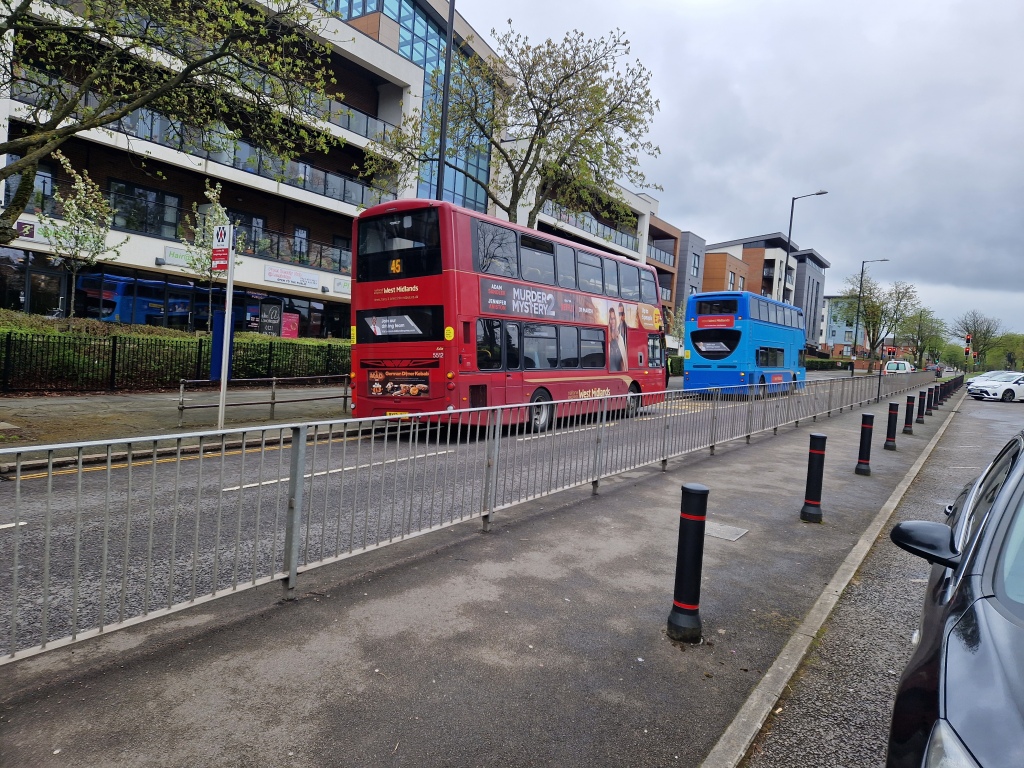
4881 pulled around first, so I let it go, then 5512 came around to the stop on the other side of the road, so I boarded, and sat upstairs, and the slightly roundabout journey back to City began. We turned right into Longbridge Lane, passing Longbridge railway station, then the Sunbury Road turning circle where the 144A had turned around, though this was first built for the extension of the Turves Green 41 service, which took place on 17th August 1958, the route having originally started just over a year earlier, on 21st July 1957. We then approached a crossroads where the 45 turns right, ironically running up the original 47 route along Coombes Lane, the 47 being introduced on 2nd April 1967, terminating at Groveley Lane (just around the corner from the 45’s current Coombes Lane route and now actually served by the 27-see blog “New Year Freewheeling”) after the semi detached houses in the area became part of the city of Birmingham (Midland Red’s 145 used to run past the top of these roads, on it’s way out to Cofton Hackett, Barnt Green & Bromsgrove.)
The 41 would be withdrawn at deregulation, then the 47 would be extended slightly across the city boundary in 1996, providing a much improved bus service to Cofton Hackett (at which time, the 145 was being operated by Travel West Midlands Yardley Wood garage), one of several slight extensions of routes made at that time to absorb balancing time, and by far the longest lived of these, not being rerouted away until the July 2018 South Birmingham revisions, with the X20 replacing, so now the village is served by the half hourly 27, the hourly 20A and Diamond’s hourly 145, now doing a double run from it’s Rubery-Bromsgrove route. (2024 update; The 27 has now been consiedrably shortened to run from Yardley Wood Garage-Frankley, so the 20A & 145 are now the only buses through Cofton Hackett)
The 47 today, however, has virtually revived the 41, turning left from Longbridge Lane and heading into the Turves Green estate that the 41 was originally created to serve, with some of the fifites maisionettes still surviving, alongside a small number of sixties blocks of flats, but a lot of new housing that has sprung up in recent years, has replaced many of them. A large number of the original Turves Green residents would have found jobs at the then growing Austin car plant at Longbridge, the demise of which has caused a fair degree of unemployment and hardship in the area, but at least the 47 bus provides access to jobs in town and elsewhere, so I think replacing it with a rerouted and hence more roundabout 45 route, even on a higher frequency, would have been a bad idea that I’m glad didn’t take place.
The council housing along Staple Lodge Road is eventually swapped for rather grander housing the closer you get to the environs of Kings Norton, this section would have been left to the 49 (Solihull-Rubery Great Park) if the 47 had gone, this route joining us from the seventies council housing of Vardon Way, before both routes head onto the Pershore Road, joining the 45 for the run up the hill to Kings Norton Station, where the 49 turns around at the roundabout to head back down the hill on it’s journey to Solihull (the “New Year Freewheeling” blog features a trip on the 49) whilst the 45 & 47 cross over into the Edwardian suburb of Cotteridge, passing the flats on the right that were built on the site of the former Cotteridge tram depot, which became a bus garage when the 36 tram (which terminated right outside the depot) was replaced by the 45 bus, extended through Kings Norton to West Heath, on 6th June 1952, the same date that the Bristol Road trams went. And the 45 was the only route that the small garage ran until the 1957 introduction of the 41, followed by the 1967 introduction of the 47.
1970 would see the garage’s ex Birmingham City Transport (BCT) 1967 vintage Metro Cammell bodied Daimler Fleetlines replaced by Park Royal bodied Fleetlines that dated from 1968/69, the last buses to enter service with BCT, these dual door Fleetlines converting the three routes to one man operation and becoming synonomous with Cotteridge garage until Mk 2 Metrobuses started to arrive there in replacement in 1982, the last ex BCT Fleetline bowing out in 1983. By this time though, Cotteridge had gained a little more work, with the 4 from Cotteridge-Hawkesley transferring over from Yardley Wood in the mid seventies, later extended to Northfield, along with a new peak service 5 to Longbridge, whilst 1977 would see the 49 commence from Cotteridge-West Heath via Vardon Way, this being extended to Longbridge in 1978, Frankley in 1979, Gannow in 1980 and Northfield in 1984! Cotteridge would close on 25th October 1986, the day before deregulation, with the 4 (replaced by the extended Yardley Wood operated 27, that section now covered by Stagecoach route 46. The 5 had gone a few months earlier) and 41 withdrawn, whilst the 49 transferred to Yardley Wood and merged with that garage’s 165 from Cotteridge-Solihull. The 45 & 47 transferred to Birmingham Central, where they still are, though this garage’s future is destined to be quite short, with property developers having acquire the land for new housing to be built in connection with the opening of HS2’s Curzon Street station. Currently, two new garages are being proposed to replace it, which I suspect will be all emissionless buses from the start, so I suspect that the B5s will be withdrawn at the time of Birmingham Central’s closure though, with neither site having yet been confirmed, that demise is likely to be 2025 at the earliest, meaning that they should be around for a little longer than their earlier B7 sisters.
We headed down the quite narrow Pershore Road, which is surrounded by Edwardian terraced housing and shops. With a steady descent, a veer to the left reveals a, to me, familiar and much admired view of Birmingham City Centre which, being sited on a plateau, is visible from all sides of the city, with an ever increasing number of tower blocks appearing in recent years, making older blocks like the distinctive, round Rotunda building fade into the background somewhat. That list of tower blocks continues to grow, with several currently under construction, reaching upwards towards the sky!
The narrowness of the main road continues into Stirchley, again filled with Edwardian terraces, where it’s very easy to visualise 36 trams trundling along! A 20 MPH speed limit now exists along here, creating a degree of controversy and congestion. It’s difficult to see how any bus priorities could be installed along here to improve the flow of the 45 & 47. We soon reached the Birmingham Nature Centre, after which, Pebble Mill Road, once home to the BBC’s Pebble Mill studios but now the location of the Birmingham Dental Hospital, branches to the left, this being the route that the 36 tram once took, this being placed onto Birmingham’s first tramway reservation in 1919, this paving the way for the reserved track Bristol Road trams, that thoroughfare being at the other end of Pebble Mill Road, the 36 joining the Bristol Road routes for the run to the terminus at Navigation Street. When the trams ceased, though, the opportunity was taken to utilise the flexibility of the replacing buses, with the 45 continuing along the Pershore Road, which would also be used by the subsequent 41 & 47. Midland Red’s 145, 146 (Rednal) & 147 (Redditch & Astwood Bank) would continue to use Pebble Mill Road though, until their final demise, when the by then Diamond operated 146 to Redditch ceased during 2020. Pebble Mill Road still has a bus service though, and in a weird way, this could now be described as a Midland Red return, as well as a return to the area of a 41 bus (only now running from QE Hospital-Heartlands Hospital), as this route is now operated by Stagecoach, currently from the ex Midland Red garage at Rugby!
Now in Edgbaston, the houses become that little bit grander, although being from the Victorian/Edwardian era, they’re now a bit faded, the area not being as affluent as it obviously once was. Entering the city along Sherlock Street, I soon noted that one of the under construction tower blocks that I’d noticed being built on the hilly stretch near Stirchley, was being built here, a block that I’d also noticed rising up from my more frequent viewings from the Northern side of the city, and had wondered exactly where it was! Now I know! Then, we entered the City Centre along Upper Dean Street, next to the Bull Ring Markets, and headed up to the 45 & 47’s Moor Street city terminus, where the driver changed the blinds to head out as a 45;

And so, my various moves for the day accomplished, I made my way over to the West Midlands Metro’s Grand Central stop, catching CAF Urbos 3 37 home, having enjoyed a nice day spent largely travelling on Wright Gemini bodied Volvos, with the highlight being a trip to and from Bromsgrove on two twenty year old examples!
Hello do you know the last bus o Bromsgrove does it go back o west brom depot and would it be able to travel on motorway from Bromsgrove to West brom a 15 miles
Not sure, to be honest!
LikeLike